BY: KENZI HANNUM
Yep – you read that title right. Three-dimensional printing of food…if you’re like me you might be scrunching up your forehead as you attempt to wrap your mind around what I just said. Printing? 3D? Food? When I think of printing, I picture what you do when you send a document from your desktop to the big Xerox machine that spits out a piece of paper covered in ink. Now there is no extra dimension there, and it’s definitely not edible! Kenzi, are you talking crazy talk!?

https://www.cybera.ca/assets/Uploads/2.gif
I’ve spent the last few years attempting to make logical sense of 3D printing, let alone printing of food! My brain just could not come to terms with it so the never-ending spiral of pondering just continued. But, no matter how many times I fail to come to a conclusion about this topic, the reverie keeps coming back up so I figured it was time to finally get down to the bottom of it and actually do some research. In my investigation for this post however, I started to question myself…did my lack of ability to understand the concept cause me to get behind the technology of the times? The majority of news coverage and articles started back in 2015, even citing studies and prototypes prior to that! This is not a new trend necessarily, but one that actually has a lot of momentum surrounding it and might even be here to stay. So back to business…what exactly is food printing?
Here is how it works:
The official definition of printing “is to impress something in or on” (Merriam-Webster). So, in the conventional way that we come to understand printing, your printer (or machine) is impressing ink (a liquid) onto a piece of paper (a surface). When we print off a sheet of paper the printer only needs to make that impression once and voila! You have a beautifully printed sheet of paper! So, what if your printer made that impression with the ink over and over again on the same spot? You would assume that the ink locations will get bulkier and you will start to see it rise from the paper…do you see where I am going with this? Suddenly with each layer you begin to find yourself creating something in three dimensions! Boom! We have 3D printing!

http://i.makeagif.com/media/6-09-2015/rJNq3k.gif
3D printing is an additive manufacturing practice that creates the 3-dimensional object by depositing a layer on top of another layer of your material (Godoi et al. 2016; Yang et al. 2017; Severini et al. 2018). Originally 3D printing was commonly used for design, prototyping, even construction applications and that much of the food uses are an adaptation of these practices. For the purpose of creating food, this material needs to be edible, and in liquid or flowable powder format prior to extrusion and deposition. Pressure is an important parameter in this process to ensure the appropriate amount of food is deposited properly. Since food can be an extremely complex matrix, some food liquids might expand once deposited due to the release in pressure after extrusion.
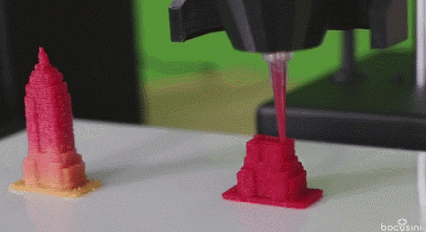
https://www.iphoneness.com/wp-content/uploads/2015/05/14/bocusini.gif
Okay I’m following you, but why do I care? What does this afford us?
Now, I recognize that I am personally obsessed with anything that manipulates food or our perception of the world we live in and, others, maybe not so much. So, if you belong in the latter group, you are probably wondering what the point is to printing food. Why not just make it like we normally do? What is the advantage to this trend? What does it afford us? Granted even though 3D printing might be a strange concept to grasp but once you do you will realize that with this method…the applications are endless. You’re in complete control – so let your imagination run wild! One author claimed that 3D food printing could revolutionize the industry due to its ability to manipulate shape, color, flavor, texture and nutrition (Sun et al. 2015). The capabilities are truly astounding. If you think of it like your normal printer, you can tell the printer exactly what you want it to print and boom—it does it! This 3D printing works the same way. You tell it what design you want to make and boom—there you go! You want something that resembles an apple yet tastes like cherry—you can do that! You want to make a pizza—why not! How about an intrinsically detailed decoration for your wedding cake—you bet!

3D printed pizza prior to cooking! https://cdn.foodbeast.com/content/uploads/2017/03/3dprintedpizza.png
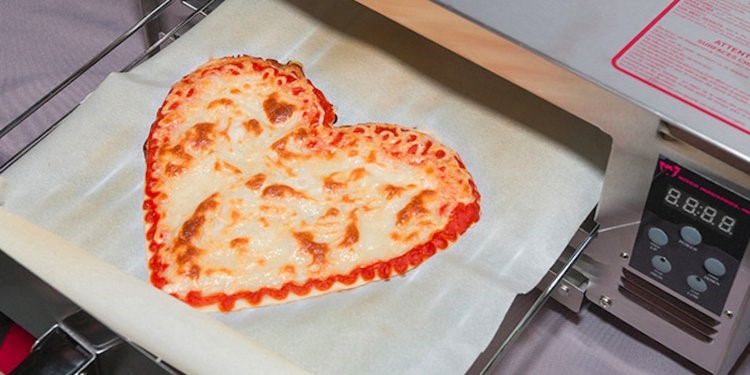
3D printed pizza post cooking
https://amp.businessinsider.com/images/575e1186dd0895434b8b4675-750-375.jpg
While your creativity can run wild with the endless amount of opportunities, especially when it comes to design and aesthetics, 3D printers also can possess direct health implications. People with dysphagia (moderate to severe difficulty of swallowing) can now eat normal-looking foods! 3D food printing has afforded researchers the opportunity to play with the texture of a food product, such as making a product that is softer and easier to swallow, but still looks appealing and behaves like a normal product (Kouzani et al. 2017). Some even see 3D food printing being a player in personalized nutrition. By using 3D food printing, one can make the same food but different for different people depending on their biometrics and personal preference. 3D food printing can allow you to improve the texture, flavor and even appearance of a product! Some have discussed its use for astronauts in flight to add choices and variety to their meals! You may now even be able to do it yourself at home!

Natural Machines Mini Burgers and Spaghetti
https://www.naturalmachines.com/site_media/132/o/
https://www.naturalmachines.com/site_media/117/o/
Hershey’s explored the use of 3D printed chocolate, allowing for the ability to create personal messages on chocolate bars or new and intricate shapes (Youtube Video)! Natural Machines, the maker of Foodini (a 3D food printer), demonstrates Foodini’s capabilities to make mini burgers, spaghetti and even a mockup of Cheerios, called “Cereal Oat O’s.”
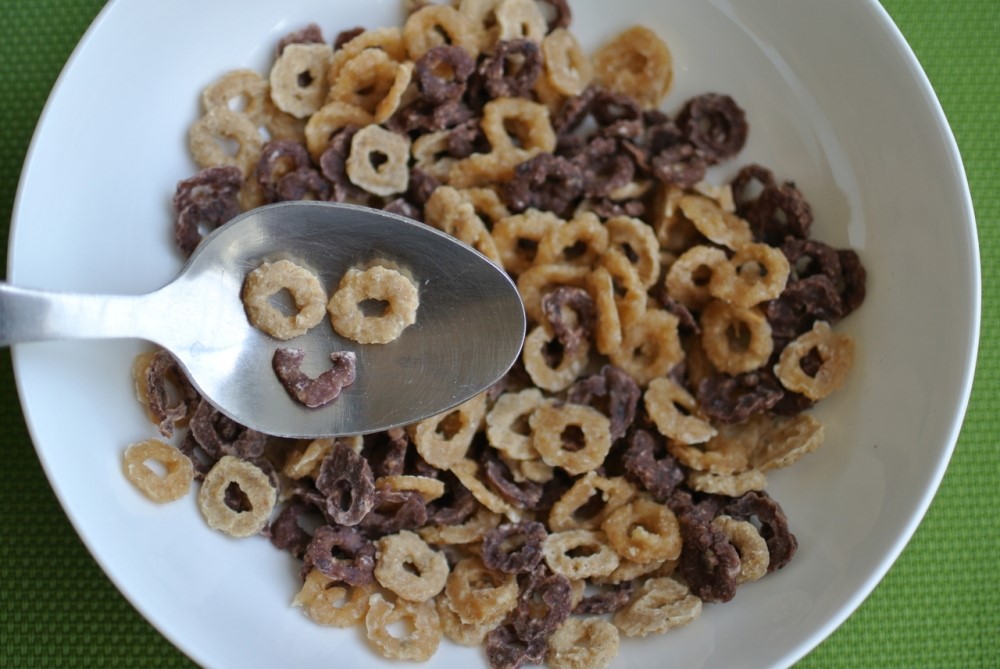
https://www.naturalmachines.com/site_media/243/o/
So, what is the catch…
While there have been huge strides in the realm of 3D printing, there are still some limitations to the technology. First and foremost, many of the 3D food printers do not also possess the ability to cook the product. Therefore, from a manufacturing perspective the process is not completely self-sufficient and does require additional preparation steps such as cooking. Secondly the process can be time consuming as it creates the product layer by layer. However, this has improved dramatically over the years and can be manipulated by the various types of food applications. The more complex a design is, or food product, the longer it will take. While pizza at its simplist consists of dough, tomato sauce and cheese, it will take time to switch out the various foods if operating on only one printer. Because a 3D printer is automated, you could tell the 3D printer to make food before a meal from your computer or phone. An advantage is that you can share designs via the internet, however, the designs are done on a software program that is specialized for 3D printing. With 3D food being relatively new the designs are limited and therefore customization is very time consuming. Since it is a novel technology, the price for these machines still remain costly so it will be some time before 3D printers are adopted by the mainstream household. Lastly, it is important for 3D printer developers to determine proper cleaning protocols to ensure food products are safe to eat and maintain their high quality over the lifetime of the 3D printer.

https://icdn3.digitaltrends.com/image/future-of-food-3d-printers-foodini-xlarge-header.jpg?ver=1
What is next for 3D food printing?
Restaurants! If you read my previous blog (When Food Science Meets Culinary Innovation: An Overview of Molecular Gastronomy) about molecular gastronomy this shouldn’t come as a surprise! 3D food printing has gained traction in the culinary world as it is an easy and efficient method to produce identical and very intricate designs. It also can create new shapes and textures for products by incorporating completely different food materials in different layers, eliciting that sense of surprise and elation in the customer! There is even a restaurant whose menu items are made solely from 3D food printing, called Food Ink (Watch this really cool Youtube video). Their motto is, “Taste tomorrow today.”

http://futuristicnews.com/wp-content/uploads/2016/07/Futuristic-Restaurant-The-Future-Of-Food-Food-Ink-3D-Printing-Restaurant.jpg

https://i.ytimg.com/vi/xk9hNin_sag/maxresdefault.jpg

Food Ink Restaurant
http://foodink.io/wp-content/uploads/2017/02/DSC05135-copy-1-1024×683.jpg
References
Godoi FC, Prakash S, Bhandari BR (2016) 3d printing technologies applied for food design: Status and prospects. J Food Eng 179:44–54 . doi: 10.1016/j.jfoodeng.2016.01.025
Kouzani AZ, Adams S, J. Whyte D, et al (2017) 3D Printing of Food for People with Swallowing Difficulties. KnE Eng 2:23 . doi: 10.18502/keg.v2i2.591
Severini C, Derossi A, Ricci I, et al (2018) Printing a blend of fruit and vegetables. New advances on critical variables and shelf life of 3D edible objects. J Food Eng 220:89–100 . doi: 10.1016/j.jfoodeng.2017.08.025
Sun J, Zhou W, Huang D, et al (2015) An Overview of 3D Printing Technologies for Food Fabrication. Food Bioprocess Technol 8:1605–1615 . doi: 10.1007/s11947-015-1528-6
Yang F, Zhang M, Bhandari B (2017) Recent development in 3D food printing. Crit Rev Food Sci Nutr 57:3145–3153 . doi: 10.1080/10408398.2015.1094732
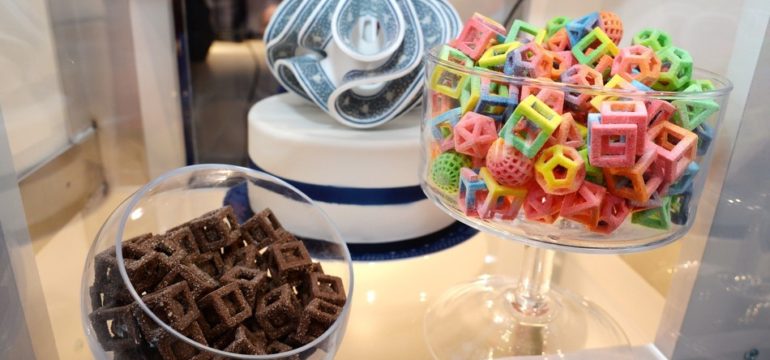




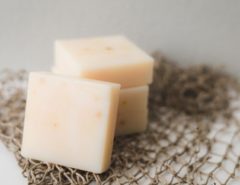
For the printing software error you can check the fix error 0xc00d36c4 for the updated process.
I just read about QuickBooks Error Support that is helping people to solve the errors that they are facing in their software.
I thought this as an informative piece to share with all of you.